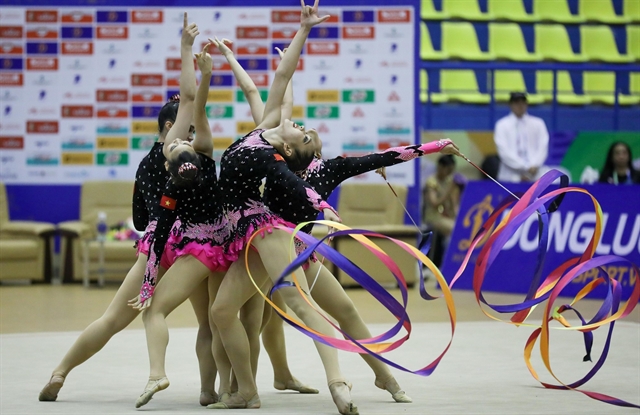 Sports
Sports

 |
| Rhythmic gymnastics is a sport with great potential in Việt Nam. — Photo toquoc.vn |
HÀ NỘI — Rhythmic gymnastics is a sport with great potential in Việt Nam, but it is still to be developed due to various factors, including adequate facilities and qualified human resources.
During the 2023 National Gymnastics Championships held last month, only four teams took part, HCM City I and II, Hà Nội, and Bình Dương, with a small number of competitors, just over 30. These numbers highlight the limited depth and breadth of the sport, both in terms of facilities and human resources.
"The development of gymnastics is challenging due to its unique characteristics," Nguyễn Thị Lý, chairwoman of the Arts Council of the Việt Nam Gymnastics Federation, said.
"The level of coaching must be guaranteed in order to train the best athletes. Currently, we only have a few qualified coaches, such as Phùng Lê Thi and Nguyễn Thu Hà.
"As a result, rhythmic gymnastics is mainly developed in major cities, making it challenging to expand its reach to provinces."
Rhythmic gymnastics requires a significant number of facilities and special equipment to ensure the quality of training for athletes.
Furthermore, the selection and training of young athletes also face many difficulties. Rhythmic gymnasts are typically recruited at a very young age and undergo a rigorous training process over an extended period before they can compete. Rhythmic gymnastics not only demands high technical skills but also incorporates auxiliary disciplines such as ballet, dance, or rhythmic gymnastics.
For athletes in this discipline, apart from talent, they also need perseverance and dedication to achieve high levels of achievement. However, not every athlete possesses the necessary perseverance to pursue this demanding sport.
Thu Hà, a rhythmic gymnastics coach, said: "To train an athlete to compete, it takes at least four years, and we usually train them from a young age, typically starting at six or seven years old.
"During the training period, athletes face difficulties and encounter high technical and physical requirements. Some athletes may struggle and choose to pursue a different path, necessitating the need to recruit and train new athletes from scratch. This results in a modest number of athletes in the sport."
According to Lý, the Việt Nam Gymnastics Federation is actively focusing on promoting coach training in rhythmic gymnastics. In recent times, the federation has invited international experts to Việt Nam to conduct training sessions aimed at improving the quality of coaches and referees in the country.
Regarding athlete recruitment, the federation has also implemented a plan to expand movement-based tournaments in different provinces. Through these tournaments, coaches will have more opportunities to evaluate and select young athletes, preparing the next generation for the national team.
Bùi Trung Thiện, the head of the gymnastics section of the sports authority of Việt Nam, said: "The federation's direction is to expand the sport to different provinces and organise training classes with former professional athletes as coaches."
Additionally, Thiện mentioned that the federation intends to combine joint training sessions between Rhythmic gymnastics and other types of gymnastics to leverage similar facilities and alleviate the pressure on localities in developing the sport. — VNS




